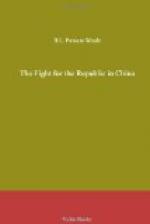The crash in Peking, when the siege of the Legations had been raised by an international army, found him alert and sympathetic— ready with advice, ready to shoulder new responsibilities, ready to explain away everything. The signature of the Peace Protocol of 1901 was signalized, by his obtaining the viceroyalty of Chihli, succeeding the great Li Hung Chang himself, who had been reappointed to his old post, but had found active duties too wearisome. This was a marvellous success for a man but little over forty. And when the fugitive Court at length returned from Hsianfu in 1902, honours were heaped upon him as a person particularly worthy of honour because he had kept up appearances and maintained the authority of the distressed Throne. As if in answer to this he flooded the Court with memorials praying that in order to restore the power of the Dynasty a complete army of modern troops be raised—as numerous as possible but above all efficient.
His advice was listened to. From 1902 until 1907 as Minister of the Army Reorganization Council—a special post he held simultaneously with that of metropolitan Viceroy—Yuan Shih-kai’s great effort was concentrated on raising an efficient fighting force. In those five years, despite all financial embarrassments, North China raised and equipped six excellent Divisions of field-troops—75,000 men—all looking to Yuan Shih-kai as their sole master. So much energy did he display in pushing military reorganization throughout the provinces that the Court, warned by jealous rivals of his growing power, suddenly promoted him to a post where he would be powerless. One day he was brought to Peking as Grand Councillor and President of the Board of Foreign Affairs, and ordered to hand over all army matters to his noted rival, the Manchu Tieh Liang. The time had arrived to muzzle him. His last phase as a pawn had come.
Few foreign diplomats calling at China’s Foreign Office to discuss matters during that short period which lasted barely a twelve-month, imagined that the square resolute-looking man who as President of the Board gave the same energy and attention to consular squabbles as to the reorganization of a national fighting force, was almost daily engaged in a fierce clandestine struggle to maintain even his modest position. Jealousy, which flourishes in Peking like the upas tree, was for ever blighting his schemes and blocking his plans. He had been brought to Peking to be tied up; he was constantly being denounced; and even his all powerful patroness, the old Empress Dowager, who owed so much to him, suffered from constant premonitions that the end was fast approaching, and that with her the Dynasty would die.




